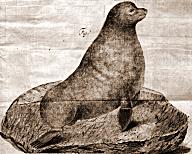Plenisner and Berckhan
Fortunately four contemporary illustrations have been found, which were, as Stejneger believed
*)1936: Appendix A, copies of sketches drawn from nature by Plenisner on Steller's request. These will be shown and annotated on the following pages.
Three of these show the seacow together with a Northern Fur Seal Callorhinus ursinus and to his right a Steller Sea Lion Eumetopias jubatus. Two are inserts on sea charts, which the naval officers Second Lieutenant Waxell and Master Chitrov had supplied as part of their expedition report. While there are various shapes of seacows on these four illustrations, the seals are very similar in posture and numerous details, evidence for a common source.
This copper of a male Northern Fur Seal (Table XV, Fig. 1 of the latin 1751 edition of
'de Bestiis marinis'), was etched after a pen-and-ink drawing by Johann Christian Berckhan
*)Hintzschte 1996, S. 170 und 283.
Johann Christian Berckhan (see biography below) was one of the academic painters of the Second Northern Expedition who frequently worked for Steller. Berckhan painted excellent watercolours and carefully elaborated drawings. He did not take part in Bering's voyage to America, but re-joined Steller in Bolscheretsk after his lucky return 1742, at that time Plenisner accompanied them. Here Berckhan probably drew the horny masticatory plates which Steller had brought from Bering Island (Table XIV in the 1751 edition of 'de Bestiis marinis') and this Northern Fur Seal.
 male
male
fur sealIt may be seen that this image does not show the typical short pointed nose of the living male animal. Berckhan never saw a live fur seal. Therefore Stejneger assumed that the artist making the original
'must of necessity have been Plenisner, though it may have been touched up by Berckhan'*)Stejneger 1936: Appendix A, S. 525.
The sketch by Plenisner presumably also served as model for the fur seals in the following Waxell/Chitrov-drawings. Plenisner was Waxell's subordinate and it is probable that that Plenisner made copies of his sketches for his superior.
On the following pages I show the contemporary pictures in the sequence of their discovery, and adopted the titles used by Buechner
*)1891 and Stejneger
*)1936, Appendix A.
Johann Christian Berckhan
Born 12th April, 1709 in Moscow
1727 Student at St. Petersburg Academy's Gymnasium.
From 1724 he and the other Russian pioneer expeditionary artists acquired drawing and engraving skills. The Natural Sciences training was run by Georg Gsell and his wife Dorothea Maria Gsell, youngest daughter of Maria Sybille Merian.
1732 to March 1747 participant as academic painter of the Great Nordic Expedition under Gmelin and Müller.
1741/42, during Steller's voyage with Bering to America, leader of the Kamchatka Group.
The artist's work attracted much attention and was adequately appreciated. The Academy of Sciences decided that Berckhan should work as a drawing teacher at the Kunstkamer, where he was still employed 1750.
Johann Berckhan died on 10th May, 1751.
*)Source: http://vitiaz.ru/congress/en/thesis/74.html
(This biography is incomplete, further details and corrections are welcome)

